Hi everyone!
We’ve had another great day in Guaranda! Our theme for today’s activities was education. This morning we took the bus to the community of Las Gradas to tour a school in the local area. Unidad Educativa Communitaria Intercultural Bilingue Rumiñahui is a small school located eight kilometers from Guaranda in an area composed of seven indigenous communities. The school was founded in 1981 to support the needs of children in the area. The inspector/Dean of the school told us that the first classes were provided in a communal house with 58 students. Since then, the school has gone through at least seven reorganizations and today provides education for about 360 students. After a brief overview of the history in Las Gradas, we had the opportunity to learn a few basic phrases in the indigenous language (Kichwa – 80 percent of students speak it). Some greetings include imanalla (hello), and alli puncha mashi (good day friend). With the help of the inspector and some students, Asha and Josue demonstrated a conversation in Kichwa. Crystal and Madison translated the same conversation to English.
After a brief introduction to the purpose and values of the school, we went on a tour of the premises. The property is largely composed of agricultural spaces including gardens maintained by the students. Students in each grade spend a few hours maintaining the gardens twice each week. There is a clear emphasis on sustainability in the projects that students work on. Today we learned about their organic farming methods and students told us their strategies for making natural fertilizers and insecticides. One major crop grown at the school are uvillas (a yellow grape/tomato fruit that is high in vitamins). Las Gradas grows 300 uvilla plants and hopes to sell the fruit at local markets in the near future. Several students presented to us about the agricultural emphasis at their school and it was very impressive seeing how much they knew. The students, who were 7th graders at the school (I think the equivalent of fifth grade in the U.S.), described the life cycles of insects in the garden and demonstrated a moth trap made from a plastic jug with a candle and water. Also, it was interesting to see the variety of animals on the school property. From what we saw, there were several chickens, pigs and dogs that roamed around on their free will.
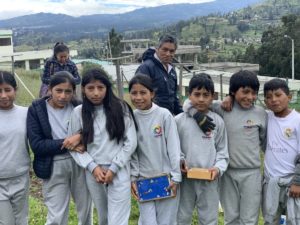
After touring the farming portion of the school, our group got to meet a group of students from first through seventh grade. Immediately after entering the school yard, we were greeted enthusiastically by this group of children. Some greeted us shyly, while others hugged us right away. One girl attached herself to Ellery and wouldn’t let go for the next ten minutes. We were greeted very warmly by the school officials, and gathered in a line to introduce ourselves.

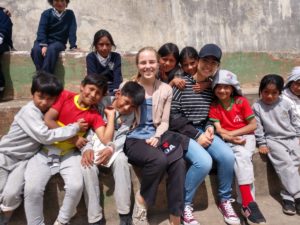
Each grade level demonstrated a game for us and we had fun participating with them. Some highlights included watermelon head-rolling races, chicken fights (two kids ran around trying to read and sound out a letter on someone else’s back), and a game involving whipping spinning objects. The kids were very friendly and were curious to know as much as they could about us. They asked some pretty funny questions, and several girls enjoyed playing with blonde hair.
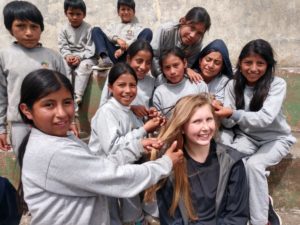
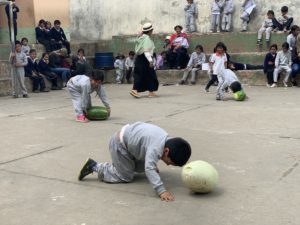
After meeting the students, we had the chance to ask questions we had prepared for the school administrators. Our group did a great job speaking in Spanish and we got a better sense of the needs of the community through these interviews. Some key issues at the school included problems with the sewage system, a lack of technology such as computers and internet connection, and a need for improved trash and recycling deposits. They also mentioned a desire for beautification, possibly involving murals and repainting. We still need to determine our goal for the Community Action Project, but it seems there are many possibilities. Still, even with a lack of resources, we realized that a quality education is definitely possible. Although the students at Las Gradas may not have access to the same privileges we have, they have an equally admirable connection to nature and their culture. In our reflection tonight, we discussed how many of us take our education for granted, and sometimes it’s beneficial to take a step back to put our experiences in context.
The rest of our afternoon was pretty relaxing after returning to Guaranda. We ate a lunch of chicken/fish/pork with a meatball soup and flan, and spent the rest of our afternoon discussing and planning our lessons for English tutoring. Even with descriptive lesson plans, it was difficult customizing our lessons and deciding what was important. After a few hours, our conversations divulged and we ended up talking in groups. Even since yesterday, our group seems to have gotten so much closer. We finished the day with a delicious dinner and passion fruit mousse. Finally, Emily and Lucy showed us an elaborate handshake to earn the leadership torch for tomorrow. Thanks for checking in today and I’m so excited to see what tomorrow has in store!
Thanks and love to Marley (and those who wrote on his behalf)!
Emma P.
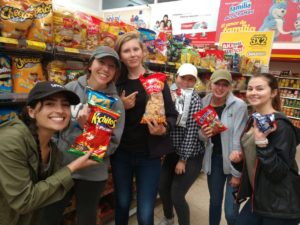
P.S. If you haven’t written a comment yet, I know there are many students who would love to hear from you! -GGLs 🙂

Sounds like an informative and culture packed day. Thank you for the wonderful write-up. It sounds like you’re getting to the deeper layers of understanding and appreciating how more alike we all truly are. Miss you and look forward to hearing more posts.
We’re proud of you Ellery Indah, and love hearing about your days in Ecuador! What a kid magnet you are. 🙂
I love the details in your update Emma P. It was almost like being there! I’m so impressed with everything the group is doing and in such a short time.
Ps. We miss you Simone! Your sister comes home from college this weekend so the house will be noisy once again.
Asha – what an amazing experience and what an important theme – education. I loved the interaction with the Las Gradas kids. And also the reflection part for the glimpsers. I am sure that you are enjoying the local cuisines and having a great time with the other glimpsers.
One more day this week before the weekend hits. Looking forward to that at home. We have a graduation party to go to tomorrow.
Love you lots my darling. You take care and have fun
Mom Dad Ravi Sparky
Hi Kalei – Happy Friday from Seattle, WA. I love the pics on the blog and can’t wait to hear your take on everything. The watermelon head game looked pretty fun, did they eat it afterwards? lol. The Warriors lost in the final against the Toronto Raptors. It was an exciting game but Klay Thompson ended up tearing his acl:( Hope you have a fabulous day! xoxo Mama
Wow, watermelon rolling is definitely in the running for the coolest sport! Awesome blog, thank you for the beautiful photos and thoughtful reflection and your learning throughout the day. The US Global Glimpse team is following along with your journeys and we look forward to hearing how your group approaches focusing the CAP project!
Everything looks like so much fun!
I can’t wait to hear more about the community action project, its really great that you all get to work together on something like that.
Lindsey Gaul! I hope you’re having fun and I miss you! All is well over here! When you get back you’ll have to tell me about any new snacks you’ve tried hahaha
Ali <3
Ooh education AND
Snacks in another country! 🙂 Lindsey, your Dad and I are loving all the photos and reading about your adventures! Your report card came – good work! Love you lots!
Hi Lindsey hope you’re having an awesome time in Guaranda! Can’t wait for the stories (and mandarina Gatorade if you can bring in your checked bag haha). When you come home we will all go back to McDonald’s to celebrate.
-Your 2nd Favorite Ambassador
Hey Yoni! (and other Glimpsers),
I am so glad that you are being introduced and immersed in this new and beautiful culture. Guaranda looks fantastic and the kids look super cute haha. The smiles on those kids made my day. You could teach those games that you played at the school to the kids at Camp Central when you get back! Anyway, I miss you Yoni and I know that you are making the most of each day. Continue to try new things, get out of your comfort zone, and enjoy every moment without technology/social media. This experience is invaluable and I can’t wait to read about your upcoming adventures.
Lots of love,
Bijan and Mom
(P.S. did you find any dope snacks at the market? Bring some back for me to munch on!!)
kieran!! oh man how did you handle the moth thing?? i hope you made a ton of tiny people friends. we miss you! hope you enjoyed aki and got some good treats.
<3 m d n t p
Wow! My heart is full of joy seeing my daughter experience something so beautiful! Crystal I hope you are having a great time. We all miss you including Miguel, tu tía Bere, tía Mela, your sisters, Mami, y papi oh and Matteo as well. We LOVE YOU!❤️
– Yanet Yanez
How beautiful all that they shared with these children very interesting games about all the watermelon. Josue you have this wonderful gift to help others, practice your Spanish with those children and teachers of that school, and help translate when someone of your classmates needs it, I love what they are doing and the places they are visiting, today was the graduation of your sister Esther received her medal of honor and her golden cord you already know by following your steps !! It was very nice everything, we miss you a lot today with us, we love you, take care of yourself and enjoy !! thanks GG for sharing these beautiful and funny moments !!